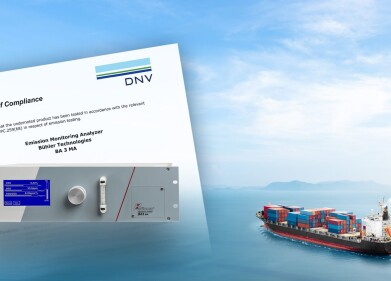Measurement and testing
Oxygen Analyser Accurately Measures Dissolved Oxygen for Offshow Water Injection Applications
May 23 2013
Waterflood or water injection is a widely used enhanced oil recovery technique used on subsea oil wells to boost production from maturing oil fields. The technique is performed by injecting water downhole to the bottom of a reservoir to keep up reservoir pressure as hydrocarbons are removed. The quality of water used is carefully monitored to protect the reservoir and the processing equipment.
Oxygen removal and monitoring of dissolved oxygen levels in the water down to the parts-per-billion level (ppb) are essential parameters in assessing the overall performance of the waterflood operation. Electrochemical cells typically have been used by well operators to monitor dissolved oxygen during waterflood. The cells, which are subject to corrosion, chemical attack and fouling, have proven inaccurate and unreliable. In addition, they are sensitive to flow and pressure changes and require frequent calibration and maintenance.
The solution is the 4401 OXY precision optical oxygen analyser from Barben Analyser Technology, a unit of Ametek O’Brien (USA). The 4401 OXY uses a proven optical luminescence technique that offers high accuracy, dependability and low maintenance. Its optical technology contains no membranes to foul or electrolyte to poison or fail. The sensor does not react with the process providing excellent long-term stability. Its sensor is unaffected by flow or pressure in liquid streams, and, while coatings from the process stream may affect measurement speed, they have no effect on accuracy.
The analyser’s sensor consists of a small luminophore that is extremely sensitive to the presence of oxygen embedded within a polymeric matrix at the end of a fibre optic cable. The analyser emits a blue light through the fibre optic cable to the sensor tip, where the luminophore in an excited state emits a corresponding red light that the analyser is able to detect. When oxygen is present, it quenches the sensor’s fluorescence at a rate that is proportional to the concentration of oxygen present. The phase shift between the excitation sources and the fluorescent signal is measured and the oxygen concentration calculated.
The 4401 OXY analyser optically measures oxygen in either the gas or liquid phase. It is suitable for direct field installation (NEMA 4X) in hazardous areas (Cl 1, Div 2). Analyser output can be read in either partial pressure (pO2 (hPA)), ppm or %O2 for the gas phases and pO2, ppm or ppb for dissolved oxygen in liquid phase.
Fibre optic sensors are available in two mechanical formats: In-Line Process Sensor and Sample Line Sensor. Each is available in multiple oxygen ranges and can be used in either gas or liquid applications. The optical O2 sensors are impervious to typical poisons (H2S, methanol) and interferences (combustibles, magnetic, CO2 and H2) and provide high accuracy and long-term stability without the need for complex or advanced sample conditioning systems.
The In-Line Sensor is fitted with convenient NPT process connections fittings, replaceable luminophore window and integral PT1000 temperature sensor and flex-conduit. It is rated for pressures up to 1,500 psig at 50oC and is suitable for most liquid phase applications.
Digital Edition
PIN 26.1 Feb/Mar 2025
March 2025
Analytical Instrumentation - Elemental Analysis for Quality and Process Control at Refineries, for Lubricants and Wear Metals in Engine Oils - Synthetic Lubricants: New Developments - Scaling...
View all digital editions
Events
SPE International Conference on Oilfield Chemistry
Apr 09 2025 Galveston, TX, USA
Apr 14 2025 Moscow, Russia
Apr 15 2025 Moscow, Russia
Apr 22 2025 Hammamet, Tunisia
Apr 22 2025 Kintex, South Korea



















